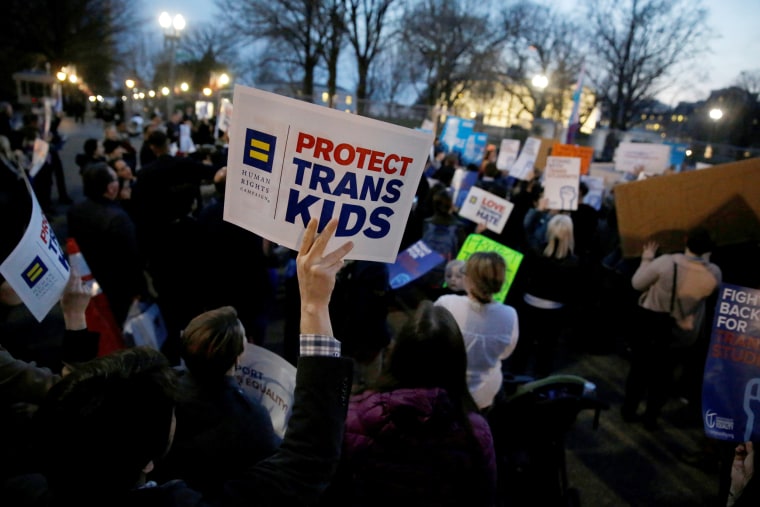When André Perez was dating a transgender partner who was bipolar years ago, he described his nights as tumultuous, sleepless and “filled with crying and yelling.”
“In the morning, I’d go to work having not slept all night and still be scared for the well-being of the person I love, and I didn’t feel like I could talk about it,” said Perez, a transgender man living in Chicago. “There would be nights when I didn’t know if they’d make it out of the night alive, thinking they were a danger to themselves and would be suicidal."
In search of an outlet, the 28-year-old took on the role of director of Marketing and Communication at Trans Lifeline — the first U.S. crisis hotline dedicated specifically to supporting the transgender community and staffed entirely by non-gender conforming people. The helpline lends an ear to a population that is at a high risk of suicide and self-harm.
This week, the helpline saw a spike in calls in the days following President Donald Trump's reversal of previous guidance from Barack Obama's administration on transgender bathroom protections in public schools.

Throughout January, Trans Lifeline saw an average of 139 calls per day. But on Feb. 23, that number shot up to 379 calls — the highest since the day after Trump’s Nov. 8 victory, when the center fielded more than 600 calls.
Launched in 2014, Trans Lifeline also saw a sharp spike in calls in April 2016, after North Carolina passed the controversial House Bill 2 denying transgender people the right to use the bathroom that corresponds to their gender identity, otherwise known as the "bathroom bill."
In the Republican administration's most recent move, Trump knocked down previous guidelines issued by Obama last May that required public schools to allow transgender students to use the bathroom that matches their gender identity. The new administration says that Title IX— which bans discrimination "on the basis of sex"— does not extend to gender identity and that states should establish their own transgender school bathroom policies.
Education Secretary Betsy DeVos defended states rights in a tweet Wednesday night, saying "Schools, communities, and families can find – and in many cases have found – solutions that protect all students."
Related: Trans Students Face ‘Detrimental’ Health Effects Without Fed Protection
“We see spikes when there’s a new affront to transgender rights and the idea that the transgender community can have a future in this country,” Perez said. "We see a corresponding increase in calls immediately, and then they remain elevated after that."
The Trevor Project — a suicide hotline for gay, lesbian and transgender youth — also saw a spike in calls on Thursday and Friday, said Sheri Lunn, vice president of Marketing and Strategic Engagement. The group reported a 35 percent increase in digital crisis contacts over text and chat services.
Like Trans Lifeline, the organization saw its biggest spike in calls directly after Trump's victory.
"Our community was extremely worried about what the Trump administration might mean for them," Lunn said. "What we saw immediately after the election was shock, fear, and panic and now we are seeing disgust, fear, and action."
Based on anecdotes from operators, Trans Lifeline believes the severity of the calls has also risen since the 2016 election, said the group's director of operations Nina Chaubal.
Related: Hate Violence Against Trans People Still ‘Disturbingly Common’
The helpline rates calls from low severity to high severity. A low severity call is one in which the caller is requesting resources or information, whereas a high severity calls involves an immediate crisis, such as a person harming themselves or facing a dangerous situation. With a transgender population of 1.4 million in the U.S., 41 percent will attempt suicide at one point in their lives, according to an American Foundation for Suicide Prevention study.
"Historically, these low severity calls have accounted for about 80 percent of our calls. These past couple of months, we've seen more calls where someone is in an immediate crisis," Chaubal said.
The day after Trump rescinded bathroom guidelines for schools, thousands of people rallied in support of transgender youth outside of Stonewall Inn in New York City. As elected officials spoke to the crowd, protesters waved signs reading “Trans youth, you are loved,” NBC New York reported.
In the coming month, the Supreme Court will hear oral arguments for G.G. v Gloucester County School Board, a case in which Virginia high school student Gavin Grimm argues that Title IX protections against sex discrimination apply to transgender people. The school board, which barred Grimm from using the bathroom that corresponds to his gender identity, asserts that "sex" is defined as physical characteristics assigned at birth.
Currently, 12 states have pending transgender bathroom legislation seeking to roll back protections, including Alabama and Kansas. More than 15 states have laws that protect transgender students.